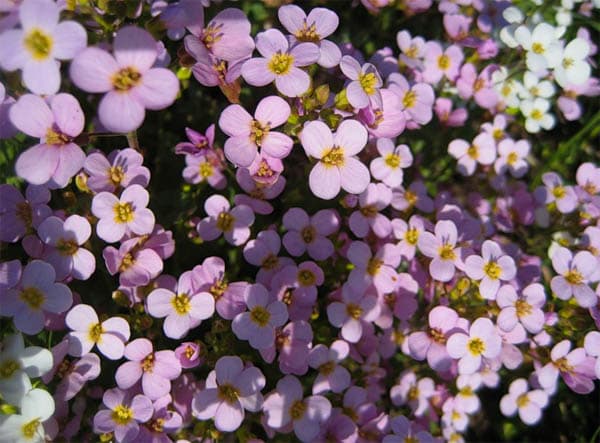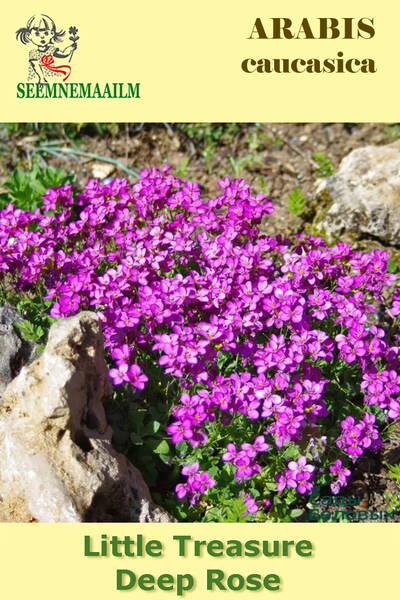An unpretentious and frost-resistant perennial - an excellent decoration for a rocky garden.
An evergreen plant that forms dense flower carpets, blooming in the first year (without vernalization).
Small oblong grey-green leaves form a dense cushion, abundantly strewn with small graceful flowers of dark pink colour.
Flowering plant height: 8-10 cm.
Natural flowering period: March - May.
Arabis prefers light sandy soils and semi-shaded soils (it also tolerates sunny places). Care consists of timely watering and fertilizing.
Winter hardiness zones: Z3 – Z7.
1,0 g = 4700 seeds.
* Some botanists consider Caucasian Arabis as a variety of Alpine Arabis. It grows in the Caucasus, Crimea, the mountains of Central Asia, the Mediterranean, and Asia Minor. A perennial plant, reaching 30 cm in height during flowering. Lodging shoots take root easily. It differs from Alpine Arabis in its more pubescent leaves.
The leaves are small, oblong, coarsely toothed along the edge, grey-green with dense white pubescence. In favourable winters, the leaves of vegetative shoots overwinter.
The flowers are up to 1.5 cm in diameter, white, collected in racemes up to 8 cm long. It blooms profusely from the beginning of June for a month, single inflorescences appear throughout the summer. The fruit is a narrow long cone. In culture since 1800.
Location: requires open, sunny places, can grow in partial shade, but in a sunny place the plant turns out to be more compact and blooms richer, grows quickly, covering a larger area.
Soil: not damp places with loose, sandy, well-cultivated soils.
Care: in the conditions of Estonia, in open places, they require light shelter. Care is the same as for other perennials. Particular attention must be paid to weeding.
Arabis grow quickly to the sides and can choke out plants growing nearby, so it is necessary to shorten shoots that grow strongly and go to the sides, which significantly improves flowering next year. They die from stagnant winter waters. When the snow melts early, the shoots suffer from drying out and require shade.
Reproduction: by seeds, double forms - by dividing the bush and cuttings.
Seeds are sown in spring or before winter, seedlings bloom in the second year. Divide 3-4 plants, from which you can get up to 20 fully developed “divisions”.
Sometimes bushes are divided without digging, by separating parts from them. Planting is carried out in spring or autumn (in August - the first half of September), maintaining a distance between plants of 30-35 cm. Cuttings are carried out from mid-May to early June. The upper part of the current year's green shoots, 6-8 cm long, is cut into cuttings. The lower 2-3 leaves are removed and planted in this form in prepared beds. For planted cuttings, shade and sufficient watering are required.
When pruning clumps, all cut shoots are usually used for cuttings. Rooting usually occurs within 2-3 weeks. Rooted cuttings are planted in a permanent place in the same year at the end of August - September.
Use: on rocky hills, in borders and mixborders. Arabis is unpretentious and therefore suitable even for planting in cemeteries.
Partners: especially effective in combination with tulips.

Garden arabis, rock cress. Bot. syn.: Arabis alpina subsp. caucasica, Arabis albida Stev.












